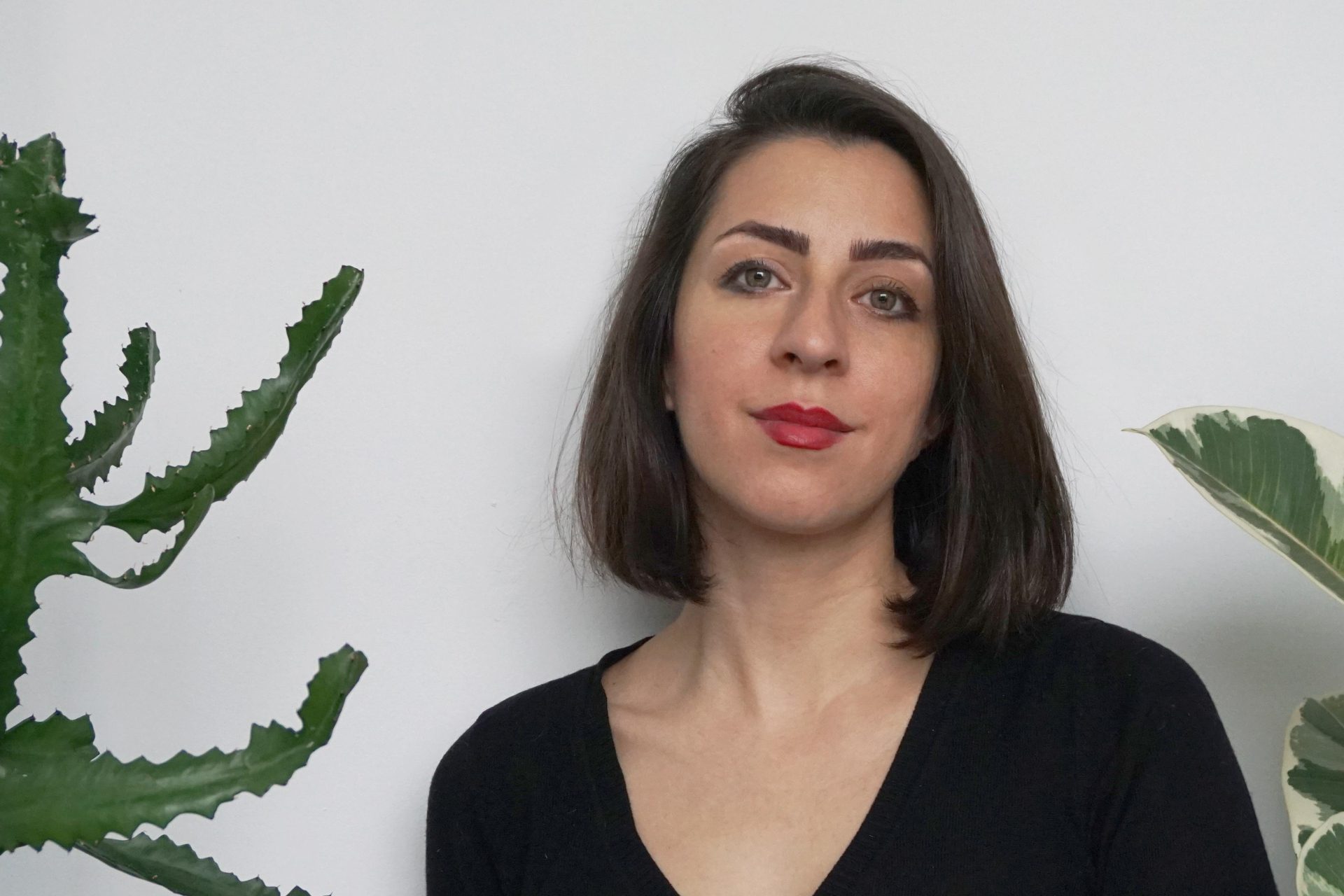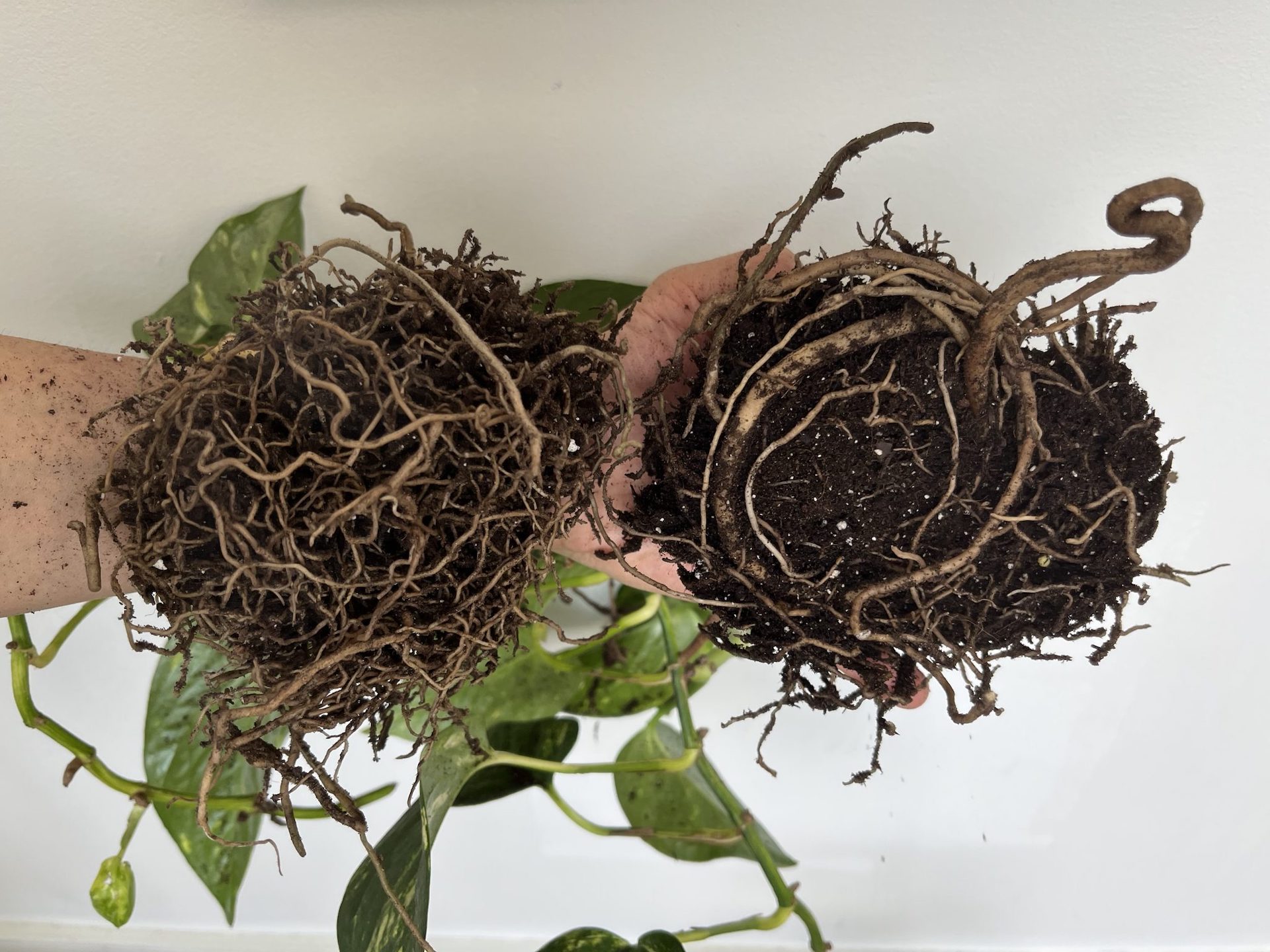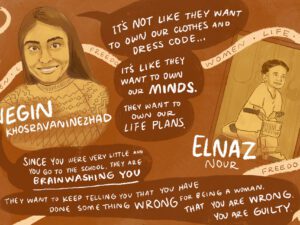 Foto cortesía de Laleh Motlagh
Foto cortesía de Laleh Motlagh Laleh Motlagh describe cómo descubrió el arte, los derechos de la mujer en Irán y su última exposición, "Enredo".
La artista afincada en Chicago Laleh Motlagh nació durante la guerra Irán-Irak en Tabriz, región noroccidental de Irán, en la provincia de Azerbaiyán Oriental. En segundo de bachillerato tuvo que elegir entre matemáticas, física, lengua y literatura o bellas artes. Motlagh, hija de un ingeniero mecánico y de la directora de una escuela de enseñanza media, tomó un camino poco convencional para sus estudios. Se decantó por las artes.
Tras ser admitida en la Escuela de Bellas Artes de la Universidad de Teherán, la familia de Motlagh siguió el consejo de su tío y se trasladó a Chicago. Recuerda cómo se adaptó a una nueva cultura y a una vida lejos de casa hace casi dos décadas. Motlagh se licenció en diseño de interiores y trabajó en el mundo empresarial durante una década. Unos años más tarde, cursó estudios de posgrado en la Universidad de Illinois, Chicago, para relanzar su carrera artística.
Desde que terminó su máster en Bellas Artes, Motlagh ha estado inmersa en su expresión artística, basándose en sus antecedentes como mujer iraní en Estados Unidos. En su última exposición, "Entanglement", en la galería de arte contemporáneo SoNA Chicago, se centra en la idea del confinamiento y el desplazamiento. Motlagh utilizó las plantas de su casa para ilustrar la adversidad a la que se ha enfrentado y las raíces que ha plantado en su nuevo hogar.
Motlagh habla de su descubrimiento del arte, los derechos de la mujer en Irán, su traslado a Chicago y su última exposición. Esta entrevista ha sido editada para mayor extensión y claridad.
¿Cómo se inició en el arte?
Nací en una familia de clase media. Mi padre era ingeniero mecánico. Mi madre era directora de un instituto, lo que no era muy común para una mujer entonces. Empecé con el arte como actividad durante las vacaciones de verano. Mis padres me apuntaron a clases de arte en Tabriz. Era muy básico. Las clases se centraban en técnicas y en el uso de distintos medios, como lápices de grafito, carboncillo o acuarela. Me gustó tanto que acabé apuntándome a clases para todo el año. En algún momento, fui a un instituto de Bellas Artes en Tabriz. Era una escuela muy buena. Nuestros profesores eran increíbles. Tenían un profundo conocimiento del arte y de la historia del arte. Disfruté mucho aprendiendo y de mi estancia en ese instituto de Bellas Artes. Un año después de terminar el instituto, gané el primer premio en un concurso nacional en Irán, lo que significaba que podía ir a la universidad que quisiera. Elegí la Facultad de Bellas Artes de la Universidad de Teherán. Pero unos meses antes de empezar los estudios, nos mudamos aquí. Nunca acabé yendo a Teherán ni a la Universidad de Bellas Artes.
Noticias que ponen el poder en el punto de mira y a las comunidades en el centro.
Suscríbase a nuestro boletín gratuito y reciba actualizaciones dos veces por semana.
¿Qué llevó a su familia a mudarse aquí?
Mi tío se había trasladado a Chicago aproximadamente un año antes de la Revolución y era un aclamado científico. Había tenido mucho éxito en su carrera, pero no pudo visitarnos debido a la Revolución Islámica de 1979 y a la guerra entre Irán e Irak. Cuando por fin pudo visitarlo 15 años después, vio a sus hermanos. Todos estaban casados y llevaban una buena vida. Les dijo a sus hermanos, incluida mi madre: "¿Por qué no os mudáis todos a Estados Unidos para que podamos estar allí todos juntos?". Toda la familia de mi madre se mudó. Yo quería irme de Irán de todos modos, pero pensaba terminar mi licenciatura en Teherán antes de irme. Lo que pasa es que esta mudanza familiar acabó siendo unos años antes de lo que habíamos previsto. Sentía que la sociedad era muy patriarcal y lo pasé muy mal. Había mucho encierro para las mujeres, para las jóvenes. Y yo no parecía tener muchas opciones allí.
¿Cómo le limitaba este sentimiento de confinamiento?
De niña, siempre me sentí una ciudadana de segunda clase. En cierto sentido, siempre me miraban por encima del hombro. Eso no me gustaba. Yo era muy atrevida. Quería hacer cosas. Quería llevar distintos tipos de ropa. Quería hacer deporte. Cosas tan simples como esas, pero no podíamos. Siempre era "No. No se puede hacer. Eres una chica. Eso es cosa de chicos". Eran cosas sencillas, pero a esa edad, esas cosas sencillas eran tan grandes para ti; siempre eran constantes confinamientos y peleas. Siempre había limitaciones. No puedes escuchar esta música. No puedes leer este libro. No puedes llevar eso. Siempre había limitaciones. Se trataba más bien de ser un ciudadano secundario, lo cual era muy difícil de aceptar.
¿Cómo ha mantenido viva su cultura e identidad después de vivir casi 20 años en Chicago?
Tu cultura permanece viva dentro de ti. Hay cultura, biografía, raíces y dónde crecí. Todo eso está ahí. Pero, como ya he dicho, los confines también están muy presentes en mis obras de arte. Lo quieras o no, es casi como si tu identidad estuviera ahí; sólo tienes que verla o quizá protegerla en algunos casos. He descubierto la manera de incorporar a mi obra dónde y cómo crecí, porque es muy importante para mí. También me gusta hacer referencia a mi trabajo como algo tan personal pero también global. Creo que muchos de estos sentimientos de confinamiento y cómo lo vive la gente en Oriente Medio, ¿verdad? No sólo nosotros, los iraníes. Muchos habitantes de Oriente Medio tienen problemas sociales similares, como el patriarcado o el hecho de ser tratados como ciudadanos de segunda clase, o el velo obligatorio, etcétera. Me gusta hablar de estos retos en mi trabajo, y creo que lo hace mucho más profundo.

¿Cómo ha intentado transmitir su identidad y sus experiencias en Enredados?
Como artista, la cultura y las raíces son importantes. Al mismo tiempo, no quiero ignorar los confines. También formaban parte de tu vida. No todo era amor y diversión en Irán. También había muchos retos. Para mí, parte de mi trabajo está relacionado con mis raíces y mi educación.
Enredos fue una exposición individual en la galería SONA en la que trabajé durante unos siete u ocho meses. También incluía una serie continua de obras anteriores. Trabajo principalmente con plantas de interior. Tengo unas 170 plantas de interior. Como saben, las plantas de interior están en una maceta. Aunque crezcan y se desarrollen, tienen que permanecer en esa maceta. Tienen que caber en esa maceta. No importa lo grandes que crezcan, siguen estando confinadas. Me identifico mucho con eso cuando hablo de mis orígenes y de la sociedad en la que crecí.
En esa exposición también incluí muchos dibujos y pinturas de mis plantas de interior y mi relación con ellas. Quería explorar esta noción de quietud, silencio, ralentización y observación. Es algo de lo que realmente se nos anima a alejarnos. En nuestra sociedad capitalista nos obligan, debería decir, a no bajar el ritmo. Estamos constantemente en plan corre, corre, corre. Esta idea era otra parte importante de la exposición.
Una cosa que siempre acompaña al inmigrante es ese espacio intermedio. No importa cuánto tiempo pases en tu nuevo país, nunca eres totalmente de allí. ¿Entiendes? En mi caso, no soy de Tabriz. Nací allí, pero no me identifico con Tabriz. Y ahora vivo en Chicago. No soy de Chicago. Vivo aquí, pero no soy totalmente de aquí. Siempre existe ese espacio intermedio, ese vacío con el que tienes que lidiar toda tu vida. Creo que eso es lo que se me queda grabado, y quizá a la mayoría de los inmigrantes.


